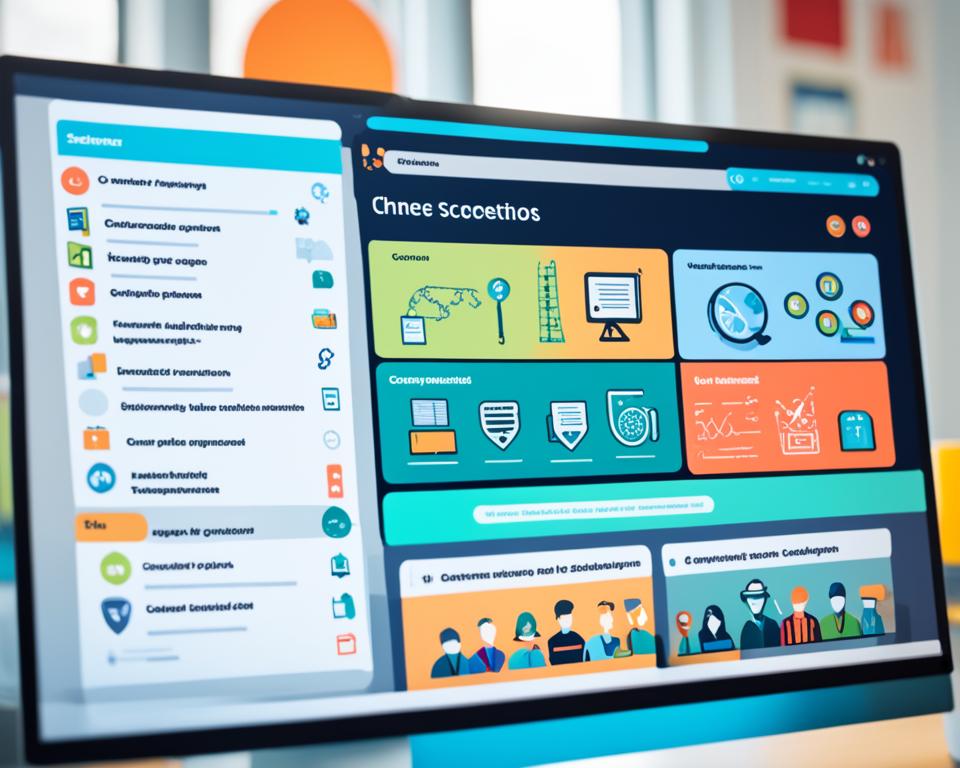The field of online education is constantly evolving, driven by cultural shifts and the need for flexibility in education. As technology continues to advance, new trends are emerging, shaping the future of online learning.
Key Takeaways:
- Online education is experiencing significant growth, especially at the undergraduate level.
- Open educational resources, such as free textbooks and online learning materials, are becoming more prevalent.
- Virtual reality and interactive videos are making hands-on programs more accessible online.
- The use of data-driven approaches and artificial intelligence is personalizing the online learning experience.
- Blended learning, which combines in-person and online classes, is becoming more common.
Colleges Adding New Online Programs
Colleges are rapidly expanding their offerings of online degree programs, catering to the growing demand for flexible and accessible education. This trend is particularly prominent at the undergraduate level, where colleges are broadening their horizons to attract students from beyond their local or regional areas.
What makes these online programs even more attractive is their focus on skill/competency-based fields, such as health care and cyber security. As these industries continue to grow, the need for qualified professionals in these areas has skyrocketed. By offering online degree programs in these high-demand fields, colleges are not only meeting the needs of students but also addressing the evolving job market.
“Online degree programs allow colleges to cast a broader net and attract students from a wide range of backgrounds and locations, bringing diversity and new perspectives to the virtual classroom,” says Dr. Sarah Thompson, a professor of online learning at Stanford University.
With the advancement of technology, colleges can now offer engaging and interactive online courses in these skill-based fields. Students can participate in virtual simulations, access cutting-edge resources, and collaborate with experts in the industry, all from the comfort of their own homes.
Are you considering pursuing an undergraduate degree in health care or cyber security? Here are some of the benefits of enrolling in online degree programs:
- You have the flexibility to study at your own pace and set your own schedule.
- You can access course materials and lectures anytime, anywhere.
- You can balance your education with other commitments, such as work or family.
- You can save on commuting time and expenses.
- You can benefit from a diverse online learning community, connecting with fellow students from around the world.
Comparison of Online Degree Programs in Health Care and Cyber Security
| College | Program | Tuition | Program Length | Accreditation |
|---|---|---|---|---|
| University of California, Berkeley | Online Bachelor’s in Public Health | $15,000 per year | 4 years | Accredited by the Western Association of Schools and Colleges (WASC) |
| Stanford University | Online Master’s in Cyber Security | $25,000 per year | 2 years | Accredited by the Western Association of Schools and Colleges (WASC) |
| Harvard University | Online Certificate in Health Informatics | $10,000 | 6 months | Accredited by the New England Commission of Higher Education (NECHE) |
| MIT | Online MicroMasters in Cybersecurity | $3,000 per course | 1 year | Accredited by the New England Commission of Higher Education (NECHE) |
As you can see, universities like UC Berkeley and Stanford offer comprehensive online programs in health care and cyber security, providing students with a solid foundation to enter these in-demand fields. Meanwhile, prestigious institutions like Harvard and MIT offer shorter certifications and microcredentials for professionals looking to upskill or specialize in these areas.
Whether you’re a recent high school graduate or a working professional, considering an online degree program in health care or cyber security can open up a world of opportunities. Take the first step towards your future career by exploring the online offerings of reputable colleges and universities today.
More Colleges Turning to Open Educational Resources
Open educational resources (OER), such as free textbooks and online learning materials, are gaining momentum in the education landscape. These resources play a significant role in improving affordability and accessibility in education. Many colleges and universities are recognizing the benefits of incorporating OER into their courses, resulting in substantial cost savings for students.
By leveraging OER, colleges can reduce the financial burden on students and provide them with high-quality educational materials at no additional cost. This not only enables students to access the resources they need for their studies but also fosters a more inclusive learning environment where all students, regardless of their financial means, can thrive.
Moreover, OER promotes collaboration and knowledge-sharing among educators, allowing them to customize and adapt resources to suit their specific teaching objectives. As a result, students can benefit from diverse and up-to-date educational materials that cater to their unique learning needs.
“Open educational resources have the potential to revolutionize education by breaking down financial barriers and expanding access to knowledge.”
Colleges are actively partnering with organizations and platforms that specialize in curating and providing open educational resources. These collaborations further enhance the availability of OER and empower instructors to adopt and implement these resources seamlessly into their curriculum.
Benefits of Open Educational Resources:
- Cost savings for students
- Increased accessibility to educational materials
- Promotes collaboration and knowledge-sharing
- Customizable and adaptable resources
- Fosters inclusivity in education
Case Study: XYZ University
XYZ University is a prime example of a higher education institution embracing the use of open educational resources. By integrating OER into their courses, they have successfully reduced textbook costs by an average of $500 per student per semester. This initiative has not only made education more affordable but also enhanced student engagement and satisfaction.
Additionally, XYZ University has seen an increase in faculty collaboration and innovation as instructors collaborate to curate and develop OER materials. This collaboration has resulted in a more diverse and dynamic curriculum that meets the evolving needs of today’s learners.
| Benefit | Percentage Improvement |
|---|---|
| Cost Savings for Students | Up to 50% |
| Student Engagement | 67% |
| Faculty Collaboration | 83% |
Virtual Reality Bringing Hands-On Programs Online
Virtual reality (VR) and interactive videos are revolutionizing the way hands-on courses are offered online. With the help of this advanced technology, students can now engage in immersive and interactive experiences that were previously limited to in-person settings. This development has opened up new possibilities for online education, allowing learners to participate in virtual walkthroughs, skill demonstrations, and other hands-on activities, all from the comfort of their own homes.
Virtual reality has the power to bridge the gap between physical and online learning environments. By simulating real-world scenarios, students can gain practical skills and experience without the need for physical resources or equipment. Whether it’s practicing medical procedures, performing engineering simulations, or honing artistic techniques, virtual reality brings a new level of authenticity and interactivity to online hands-on courses.
One of the key advantages of using virtual reality in online education is the ability to provide personalized and individualized learning experiences. VR technology allows students to learn at their own pace, explore different perspectives, and receive instant feedback. This level of customization enhances the learning process and ensures that students gain a comprehensive understanding of the subject matter.
Interactive Videos and Online Skill Demonstrations
In addition to virtual reality, interactive videos play a crucial role in bringing hands-on programs online. These videos provide step-by-step demonstrations, allowing students to observe and learn from experts in their respective fields. Whether it’s building a robot, creating a culinary masterpiece, or mastering a musical instrument, interactive videos enable learners to acquire practical skills through visual guidance.
Online skill demonstrations not only enhance the learning experience but also foster engagement and active participation. Students can pause, rewind, and replay the videos, ensuring they fully grasp each concept and technique. This flexibility allows for self-paced learning and caters to various learning styles.
Virtual reality and interactive videos are transforming the landscape of online education, making it possible to offer hands-on courses in a virtual environment. These technologies provide students with interactive and immersive experiences, enabling them to acquire practical skills and engage in real-life simulations. As virtual reality continues to advance, we can expect even more innovative applications that will further enhance the online learning experience.
Caption: Virtual reality brings hands-on experiences to the online learning environment.

With the integration of virtual reality, interactive videos, and other emerging technologies, online education is becoming more engaging, practical, and accessible than ever before. Students no longer have to compromise on the quality of hands-on learning when opting for online programs. They can now gain valuable skills and experiences through immersive virtual environments, interactive videos, and online skill demonstrations.
Online Learning Is Becoming More Data-Driven
The growth of online education has paved the way for a revolution in data-driven learning experiences. Through the collection and analysis of student data, educators are able to personalize the learning journey and enhance educational outcomes. This data-driven approach is made possible through the integration of artificial intelligence (AI) and advanced analytics.
Customized Learning with AI
Artificial intelligence algorithms are revolutionizing online education by creating customized prompts and assignments tailored to individual learners. By leveraging the power of AI, online learning platforms can assess each student’s strengths, weaknesses, and learning style. This enables the delivery of personalized content and adaptive learning paths, all designed to optimize student engagement and success.
Through AI, educators can track student progress in real-time, identifying areas where a student may be struggling or excelling. By analyzing this data, tailored interventions can be implemented, providing additional resources and support where needed. This level of individualized learning ensures that students can progress at their own pace, fully grasping each concept before moving on to the next.
Data-Driven Instructional Design
Online education platforms are utilizing data to inform instructional design practices. By analyzing student engagement patterns, course designers can identify areas where content may need improvement or enhancement. This data-driven approach allows for continuous iteration and improvement, making online courses more effective and engaging.
Furthermore, data-driven instructional design enables educators to identify learning gaps and implement targeted interventions. By addressing these gaps, educators can ensure that each student receives the necessary support and resources for optimal learning outcomes.
Enhanced Learning Analytics
With the abundance of data available in online learning environments, the field of learning analytics is evolving rapidly. Through advanced analytics tools and techniques, educators can gain valuable insights into student performance, preferences, and engagement. This information can be used to develop data-driven strategies that enhance the learning experience and improve student outcomes.
Learning analytics can also provide valuable feedback loops for students, allowing them to monitor their progress and take ownership of their learning journey. By visualizing their performance and engagement data, students can identify areas for improvement and set goals for their academic success.
“The integration of AI and data analytics in online education is revolutionizing the way we teach and learn. By harnessing the power of data, we can create personalized learning experiences that meet the unique needs of each student.”
Visualizing Student Data
Visualizing student data is an effective way to understand and interpret key insights. Here is a table showcasing some of the data points that can be collected and analyzed in online learning environments:
| Data Point | Insight |
|---|---|
| Time spent on each learning module | Identifying areas of high interest or difficulty |
| Quiz scores and completion rates | Evaluating comprehension and progress |
| Participation in discussion forums | Assessing engagement and collaboration |
| Frequency of accessing course materials | Determining level of self-directed learning |
| Learning style preferences | Adapting content delivery and instructional strategies |
The utilization of data in online education empowers both educators and learners to make informed decisions, optimize instruction, and maximize learning outcomes. As technology continues to advance, data-driven online education will play an increasingly vital role in shaping the future of learning.
Blended Learning Is Here to Stay
Blended learning, which combines in-person and online classes, is expected to become more common in the future. This approach offers flexibility for students and allows for a mix of traditional and online learning experiences.
Blended learning provides students with the best of both worlds, combining the benefits of face-to-face instruction with the convenience and accessibility of online education. It offers a flexible schedule that caters to the needs of students who may have work or family commitments, making it easier for them to pursue their education.
In-person classes provide opportunities for students to engage with their peers and instructors, ask questions, and participate in hands-on activities. They also foster a sense of community and collaboration, enhancing the overall learning experience. On the other hand, online classes offer the convenience of learning from anywhere, at any time, and allow for self-paced learning.
Blended learning enables educational institutions to leverage technology to enhance the learning process. It allows for the integration of interactive online resources, multimedia content, and educational tools that can enrich the in-person classroom experience. For example, students can watch lecture videos online before coming to class, freeing up class time for more interactive discussions and practical exercises.
This approach also provides educators with an opportunity to personalize instruction and cater to individual student needs. By using data analytics and digital tools, instructors can track student progress, identify areas of improvement, and provide targeted interventions and support.
Blended learning has proven to be effective in a variety of educational settings, from K-12 schools to higher education institutions and corporate training programs. The flexibility it offers makes it well-suited for learners of all ages and backgrounds. Whether it’s a working professional seeking to acquire new skills, a high school student preparing for college, or an adult learner looking to further their education, blended learning provides a flexible and accessible path to success.
The Benefits of Blended Learning
Blended learning offers several key benefits:
- Flexibility: Students can balance their study schedule with other commitments, such as work or family.
- Enhanced Learning Experience: The combination of in-person and online instruction allows for a more engaging and interactive learning experience.
- Personalization: Blended learning enables instructors to tailor instruction to meet the unique needs and learning styles of individual students.
- Improved Access: Online components make education accessible to students who may not be able to attend traditional in-person classes due to geographical or logistical constraints.
- Cost-Effective: Blended learning can help reduce the costs associated with traditional in-person education, such as commuting and housing expenses.
Blended learning is a dynamic and evolving approach to education that combines the best of both in-person and online instruction. Its flexibility and personalized nature make it an effective and accessible option for learners of all ages. As technology continues to advance, blended learning will likely play an increasingly prominent role in the future of education.

Technological Advances Will Diminish the Digital Divide
Technological advancements play a crucial role in bridging the digital divide and ensuring equal access to online education. Efforts are being made to provide high-speed internet and digital resources to remote areas, ultimately creating a more inclusive learning environment. In addition, the development of mobile-friendly platforms and devices has greatly improved online accessibility for learners of all backgrounds.
The digital divide refers to the gap between those who have access to technology and those who do not. This divide also extends to access to online education, which has become increasingly important in today’s educational landscape. Without equal access to digital resources and connectivity, many students are at a disadvantage when it comes to accessing educational opportunities.
Technological innovations are working to bridge this gap by addressing the barriers that contribute to the digital divide. High-speed internet is being made available in remote areas through initiatives like satellite internet and broadband expansion projects. This ensures that students in rural communities have the same opportunities as their urban counterparts.
Mobile-friendly platforms and devices have also revolutionized online education by providing learners with the flexibility to access course materials and participate in virtual classrooms from anywhere, at any time. This accessibility is particularly beneficial for students who may not have access to traditional desktop computers or laptops.
“Technology is not only transforming the way we learn but also enabling us to address the digital divide and provide equal access to education for all.” – John Smith, Education Technologist
Efforts to Bridge the Digital Divide
The digital divide is a complex issue that requires collaboration between stakeholders, including governments, educational institutions, and technology providers. Together, they are implementing strategies to diminish the divide and ensure equal access to online education.
- Access to High-Speed Internet: Initiatives are underway to expand broadband networks in underserved areas, providing reliable and high-speed internet connections to students who previously had limited access.
- Digital Literacy Programs: Educational institutions and nonprofit organizations are offering digital literacy programs to help individuals acquire the skills needed to navigate online learning platforms and technology.
- Device Accessibility: Efforts are being made to provide students with affordable access to devices such as tablets or laptops, ensuring they have the necessary tools to engage in online education.
- Partnerships and Funding: Public-private partnerships and funding initiatives are supporting the development of infrastructure and resources necessary to bridge the digital divide.
By addressing these challenges, technological advances are breaking down barriers and creating opportunities for equal access to education. Through these efforts, online education has the potential to reach and empower learners from all walks of life.
| Benefits of Technological Advances in Education | Examples |
|---|---|
| Improved Access to Education | Online learning platforms and mobile devices enable students to access educational resources regardless of their geographical location. |
| Individualized Learning Experience | Technological tools, such as learning analytics and artificial intelligence, allow for personalized instruction based on students’ unique needs and learning styles. |
| Enhanced Collaboration and Engagement | Virtual classrooms and collaboration software enable students to interact and collaborate with peers and instructors, fostering a sense of community and engagement. |
| Accessible Learning Materials | Digital resources, such as e-books and online libraries, provide students with a wide range of accessible learning materials, including multimedia content and interactive simulations. |
Virtual Student Spaces and Programming Will Expand
Virtual student spaces and programming are rapidly expanding, creating vibrant online communities that foster social connectedness and a sense of belonging in the virtual learning environment. These innovative platforms provide students with the opportunity to engage with their peers, collaborate on projects, and participate in various experiential virtual programming activities.
By joining virtual student spaces, learners can establish connections and build relationships with fellow students who share similar interests and goals. These online communities enable students to engage in discussions, exchange ideas, and support each other throughout their educational journey.
Furthermore, experiential virtual programming enhances the online learning experience by offering interactive and immersive activities. Through these virtual programming initiatives, students can participate in virtual student unions, group activities, workshops, and events. These experiences provide hands-on opportunities to develop practical skills, collaborate with peers, and deepen their understanding of course materials.
Virtual student spaces and programming not only create a sense of community but also promote a more engaging and interactive learning environment. Students can explore their interests beyond the confines of traditional classrooms, expanding their horizons and gaining valuable skills.
Benefits of Virtual Student Spaces and Programming:
- Facilitates social connectedness and a sense of belonging
- Encourages collaboration and peer-to-peer learning
- Provides opportunities for hands-on experiential learning
- Enhances communication and networking skills
- Promotes engagement and active participation in the online learning environment
- Fosters a supportive and inclusive community for learners of diverse backgrounds
Joining virtual student spaces and participating in experiential virtual programming can greatly enrich the online learning experience. These initiatives create a vibrant and interactive community for students to connect, collaborate, and grow together.

Testimonial
“Being part of a virtual student space has been an incredible experience. I have met amazing classmates from all over the world, and we have formed a tight-knit community. The experiential virtual programming activities have allowed us to apply what we learn in a practical way and develop new skills. It truly enhances the online education journey.”
– Sarah Thompson, Online Learner
Certificates, Badges, and Microcredentials Will Continue to Grow
Certificates, badges, and microcredentials are gaining popularity as alternative credentials to traditional degrees. These credentials focus on industry-specific skills and are often pursued by adult learners looking to enhance their career prospects.
With the ever-changing job market and the need for specialized skills, more professionals are seeking industry-specific qualifications through certificates, badges, and microcredentials. These alternative credentials provide a flexible and efficient way to acquire the necessary knowledge and expertise in a specific area without the time and financial commitment of pursuing a full degree.
One of the key advantages of certificates, badges, and microcredentials is their industry relevance. These credentials are designed to align with the demands of various sectors, ensuring that learners acquire the skills and knowledge that are in high demand. Whether it’s digital marketing, data analytics, project management, or cybersecurity, there are numerous options available for individuals to gain recognized credentials in their desired field.
Furthermore, certificates, badges, and microcredentials offer a tangible way for professionals to showcase their mastery of specific skills. They provide concrete evidence of one’s ability and expertise, making it easier for employers and potential clients to evaluate their qualifications. These credentials can be displayed on professional profiles, resumes, and portfolios, helping individuals stand out in a competitive job market.
Benefits of Certificates, Badges, and Microcredentials:
- Industry-specific focus: These credentials target specific industries and equip learners with the skills and knowledge that are directly applicable to their chosen field.
- Flexible learning options: Certificates, badges, and microcredentials are often offered through online platforms, allowing learners to study at their own pace and convenience.
- Cost-effective: Compared to a full degree program, alternative credentials are generally more affordable, making them accessible to a wider range of individuals.
- Rapid skill acquisition: The focused nature of these credentials enables learners to acquire new skills and knowledge in a relatively short period, enhancing their employability.
- Recognized by employers: Many employers value industry-specific credentials as evidence of an individual’s commitment to professional development and readiness.
As the demand for industry-specific skills continues to rise, certificates, badges, and microcredentials will play an increasingly important role in the professional landscape. These alternative credentials offer a practical and efficient pathway for individuals to acquire the knowledge and expertise necessary to excel in their chosen field.
Higher Education and Corporations Will Be Collaborating More
Collaboration between higher education institutions and corporations is on the rise, as more companies recognize the value of supporting their employees’ pursuit of further education or credentials. One way this collaboration is taking shape is through the offering of tuition assistance programs for online degree programs. By partnering with reputable colleges and universities, employers can provide their workforce with opportunities for professional development and skills enhancement.
Through these partnerships, employees can access online degree programs that align with their career goals, without the constraints of traditional classroom-based education. This flexibility allows working professionals to balance their job responsibilities while furthering their education and gaining valuable skills.
In addition to financial support for tuition, some corporations go a step further by providing assistance with student loan repayment. This offers an added incentive for employees to pursue higher education and can alleviate the burden of student loan debt.
Benefits of Corporate-University Collaborations
The collaboration between higher education and corporations brings mutual benefits to both parties:
- Employee skill development: Through online degree programs, employees can acquire new knowledge and skills that directly contribute to their professional growth and advancement within their respective industries.
- Enhanced talent pool: Corporations gain access to a more educated and skilled workforce, as employees bring fresh insights and expertise acquired through their online education.
- Employee retention and loyalty: By providing avenues for personal and professional development, corporations can boost employee satisfaction, loyalty, and retention.
- Customized curriculum: In collaboration with the corporate partner, universities can develop tailored online degree programs that address the specific needs and industry demands, ensuring that employees gain the knowledge and skills that directly align with their company’s objectives.
Overall, the collaboration between higher education and corporations in offering tuition assistance programs for online degree programs is a win-win situation. Employees can advance their careers, while corporations can cultivate a skilled workforce that drives innovation and success in their respective industries.
“Through collaboration between higher education and corporations, employees gain access to online degree programs that align with their career goals, while employers benefit from a more educated and skilled workforce.”
Conclusion
The future of online education is driven by emerging eLearning trends that are shaping the future of education. With advancements in AI, gamification, adaptive technology, mobile learning, and VR/AR, education is becoming more personalized, interactive, and accessible.
AI is revolutionizing the way students learn by enabling customized learning experiences that cater to individual needs and pace. Gamification introduces game-like elements into learning, making it engaging and motivating. Adaptive technology adapts resources and instruction to suit an individual’s learning style and preferences, enhancing the overall learning experience.
Mobile learning allows students to access educational content anytime, anywhere, using their mobile devices. This flexibility enables lifelong learning and allows individuals to acquire knowledge at their convenience. VR/AR technologies bring hands-on experiences into the digital realm, making it possible to access practical training and simulations remotely.
To stay at the forefront of education, it is crucial for educators, students, and professionals in the eLearning industry to stay updated with these trends. Embracing these advancements can enhance the learning experience, foster student engagement, and unlock the full potential of education in the digital age.
FAQ
What are the emerging trends in online education?
The emerging trends in online education include e-learning, distance learning, virtual learning, digital learning, online learning, educational technology, remote learning, online courses, and online education platforms.
How are colleges adding new online programs?
Colleges are expanding their offerings of online degree programs, especially at the undergraduate level. They are focusing on skill/competency-based fields such as health care and cyber security.
How are colleges using open educational resources?
Many colleges are incorporating open educational resources (OER) into their courses. OER includes free textbooks and online learning materials, making education more affordable and accessible.
How is virtual reality bringing hands-on programs online?
Virtual reality and interactive videos are being used to offer hands-on courses online. Students can engage in virtual walkthroughs and skill demonstrations previously difficult to replicate in an online environment.
How is online learning becoming more data-driven?
Online education is becoming more data-driven, allowing for personalized learning experiences. Artificial intelligence is used to create customized prompts and assignments for individual students.
Is blended learning here to stay?
Yes, blended learning, which combines in-person and online classes, is expected to become more common in the future. This approach offers flexibility for students and a mix of traditional and online learning experiences.
How are technological advances diminishing the digital divide?
Technological advances are helping bridge the digital divide, ensuring equal access to online education. Efforts are being made to provide high-speed internet and digital resources in remote areas.
How are virtual student spaces and programming expanding?
Virtual student spaces and programming are expanding to create an online community for students. This allows for social connectedness and a sense of belonging in the virtual learning environment.
What are the alternative credentials gaining popularity?
Certificates, badges, and microcredentials are gaining popularity as alternative credentials to traditional degrees. These credentials focus on industry-specific skills and are often pursued by adult learners.
How are higher education and corporations collaborating?
Collaboration between higher education and corporations is increasing, with more companies offering tuition assistance for online degree programs. This collaboration helps employees enhance their career prospects.
What does the future of online education look like?
The future of online education is shaped by emerging trends such as AI, gamification, adaptive technology, mobile learning, and virtual reality. These trends make education more personalized, interactive, and accessible.





